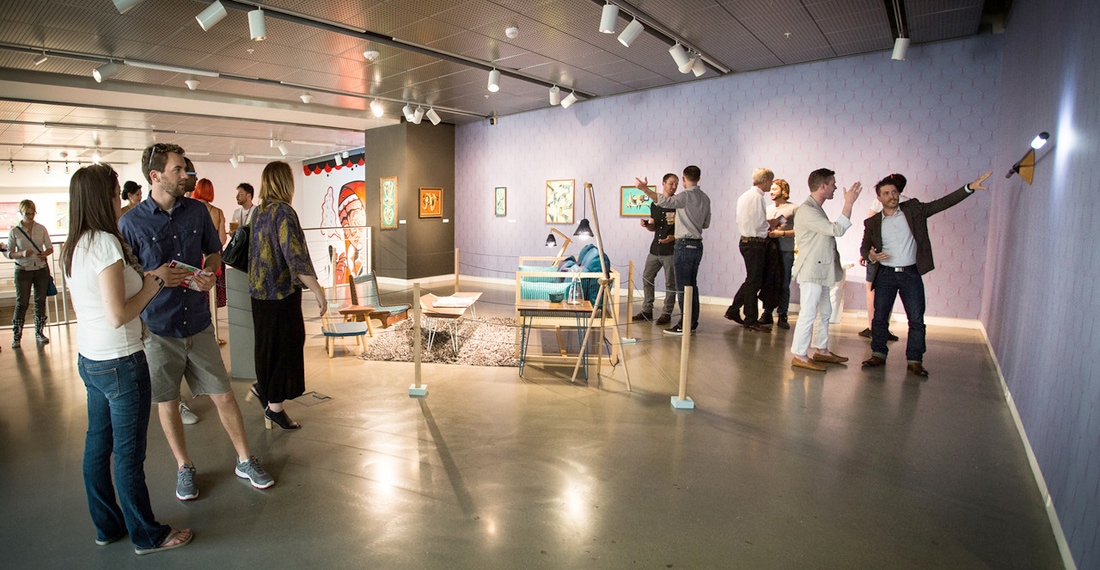The specter of a 40th birthday often marks a turning point, whether it be easing contentedly into middle age or plunging headlong into a self-destructive midlife crisis. Grand Rapids’ Urban Institute for Contemporary Arts fits neither profile. The UICA in 2017 will celebrate its 40th year of bringing forward-thinking multidisciplinary art to the city’s downtown, and the vibe is both reflective and restless.
“While nearly 40 years old, UICA is still developing into its full potential,” Executive Director Miranda Krajniak told Revue. Indeed, the institute’s story is one of constant growth and evolution.
UICA was founded as a nonprofit in 1977 by a group of artists with a shared goal of challenging audiences and supporting new forms of creative expression. Its first space on Front Street is now a parking lot for the Gerald R. Ford Museum. Following that, the institute occupied locations on Race Street near the Ford Freeway, then closer to downtown on Monroe Avenue before landing in its longtime home at 41 Sheldon Blvd. The institute remained there for 13 years before moving in 2011 to its current headquarters, 2 W. Fulton Ave.
Now firmly ensconced in a spacious, state-of-the-art $8 million facility at the literal center of the city, the UICA curates ambitious traveling exhibitions, performance art and site-specific installations throughout its 28,000 square feet of gallery space, along with dozens of art-related public and member events each year, such as the Odd Ball and Live Coverage fundraisers. Its lower-level theater presents 16 film screenings per week — mostly first-run independent and art films, documentaries and works of foreign cinema.
“UICA has had my back for 10 years now,” said Grand Rapids filmmaker Joel Potrykus, who has received critical acclaim, festival attention and national distribution in recent years for his films “Ape,” “Buzzard” and the forthcoming feature “The Alchemist Cookbook.” The UICA hosted the first screening of his short film “Gordon” in 2007.
“UICA is by far one of the most valuable, and often-overlooked, spots in this city,” he said. “There’s days I almost feel like Grand Rapids doesn’t deserve a cinema with such perfect programming taste.”
Potrykus hosts the recurring Open Projector Night series, which showcases short films, specifically emphasizing local and regional work. “The Alchemist Cookbook” has its official debut run at the UICA Oct. 14-27.
That overlaps with the final days of UICA’s ArtPrize 8 exhibition, “Future Talk,” a collection of works by 16 artists in digital and new media. The UICA has been a marquee venue since ArtPrize’s inception, and its former Sheldon Blvd. location now houses ArtPrize’s headquarters.
Two years after the move to its new space, the UICA merged with Kendall College of Art and Design. Slower than expected membership growth and admission revenues left the UICA with a $4 million debt. Kendall itself is part of Ferris State University, which paid off the debt as part of the merger agreement. UICA retains curatorial independence, but shares operational and administrative resources with Kendall, Krajniak said.
Its existence secured, the UICA has assumed the curious role of an established institution whose uniqueness for a city the size of Grand Rapids tends to be overlooked. It is, for instance, one of only 11 non-collecting art institutions in the United States — in other words, it doesn’t house a permanent collection. The focus is solely on the new (such as “superusted,” an exhibition of Midwestern art running until October), the provocative (like “Unloaded,” a recent exhibition of work exploring gun violence) and the engaging (such as its Contemporary Kids and ArtWorks programs).
“A contemporary art institute can be the place where new ideas and challenges to conventional thought are first broached as artists reflect upon the world around them,” Krajniak said. “Original forms of artistic expression are inherently challenging because we as viewers are experiencing something that’s never been apprehended before. There’s no ‘right answer’ for how a work is supposed to make the viewer feel, or what to think — no textbook entry has been written yet.”
That mission has expanded outward. The UICA is spearheading an ongoing effort to place street art in several of the city’s public spaces. So far, the partly crowdfunded “Exit Space Project” has commissioned five large-scale outdoor murals in Grand Rapids neighborhoods. One such mural covers the Lincoln Lodge at Lincoln Park on the city’s West Side. Its creator, Kelly Allen, has worked extensively with the UICA for the past dozen years as a volunteer, instructor and exhibiting artist.
“The UICA has been a major reason why I enjoy living in GR, as it has been the most professional, inspiring, forward-thinking art institution outside of Detroit, as far as I’m concerned,” Allen said.
Her mixed-media work has been featured in several shows, and in November, Allen will debut an exhibition of solo work on the UICA’s fifth floor. She said the institute “helps Grand Rapids feel like a valid contender as a vibrant, contemporary, creative city.”
The UICA accomplishes this by continuing to (here’s that word again) challenge its audience until the abnormal seems normal, Krajniak said.
“It’s significant that the West Michigan community has supported and sustained such a place for new, unconventional and challenging ideas for almost 40 years,” she said. “What may seem ‘challenging’ at UICA today may be ‘safe’ or commonplace in years to come.”





